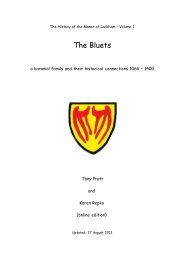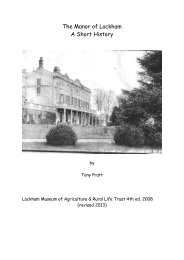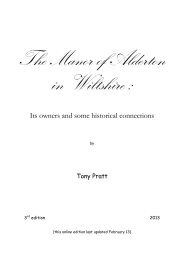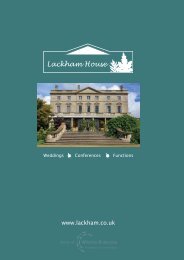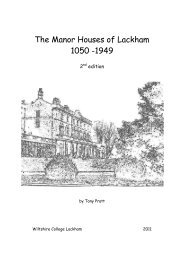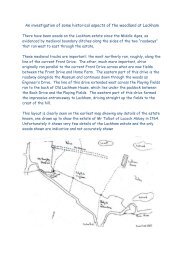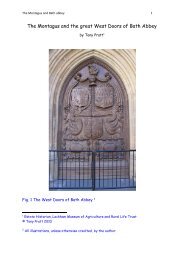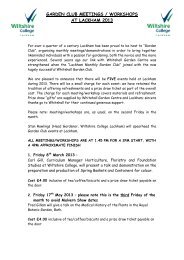History of Agricultural Education in Wiltshire - Lackham Countryside ...
History of Agricultural Education in Wiltshire - Lackham Countryside ...
History of Agricultural Education in Wiltshire - Lackham Countryside ...
Create successful ePaper yourself
Turn your PDF publications into a flip-book with our unique Google optimized e-Paper software.
DAIRY HERDS 1959-1976<br />
CHAPTER X<br />
CATTLE AND SHEEP<br />
by F A Stockwell<br />
As early as 1959 there were two dairy herds on the College farms, a Shorthorn<br />
dairy <strong>of</strong> around 30 cows based on Notton Farm and a Friesian dairy <strong>of</strong> 45 cows. At<br />
this time, the Notton Dairy was loose housed, bedded on straw and milked through a<br />
small abreast parlour direct to churn. The churns were subsequently cooled on an ice<br />
bank water cool<strong>in</strong>g system us<strong>in</strong>g rotary coolers, One man was employed to look after<br />
the 30 cows and this was considered to be a good economic unit at that time.<br />
In 1962/63 <strong>in</strong> an attempt to improve the performance <strong>of</strong> the cows at Notton,<br />
pedigree cattle were purchased from several well known Shorthorn breeders:<br />
2<br />
heifers from Mrs Field<strong>in</strong>g Johnson at £155 the pair.<br />
1 heifer from the Avoncourt Herd at £65<br />
2 heifers from The Calston Herd (Mr Maundrell) at<br />
£130 the pair.<br />
5 heifers from The Cotley Herd (Mr Osbourn) at £325<br />
(5).<br />
1 cow from Mr Turner (North Devon) at £157<br />
These cattle, together with the exist<strong>in</strong>g cows, cont<strong>in</strong>ued to perform well and<br />
ma<strong>in</strong>ta<strong>in</strong>ed a herd average <strong>of</strong> around 1000 gallons, equal to the performance <strong>of</strong> the<br />
Friesian cows <strong>in</strong> the Home Farm dairy at that time.<br />
The Shorthorns proved consistently to be very economical to feed, suffered few<br />
health problems and had a superior milk quality to the Friesian.<br />
From this time onwards, the herd size at Notton slowly <strong>in</strong>creased by way <strong>of</strong> home<br />
bred stock bred by several bulls from the M.M.B. A.I. stud and by semen purchased<br />
from other well known breeders, e.g. Maundrell and "Horlicks Farms". However, <strong>in</strong><br />
spite <strong>of</strong> us<strong>in</strong>g the best bulls available it became <strong>in</strong>creas<strong>in</strong>gly more difficult to<br />
improve or even ma<strong>in</strong>ta<strong>in</strong> the performance <strong>of</strong> the new generations <strong>of</strong> Shorthorn<br />
heifers enter<strong>in</strong>g the herd and herd averages began to decl<strong>in</strong>e. By the late 1960's,<br />
the herd size had risen to nearly 50, extra accommodation had been provided <strong>in</strong> the<br />
lower yard and because <strong>of</strong> the amount <strong>of</strong> hand work <strong>in</strong>volved <strong>in</strong> feed<strong>in</strong>g, clean<strong>in</strong>g out<br />
and bedd<strong>in</strong>g them down, plans were put to the Governors for modernisation at<br />
Notton Farm.<br />
In 1968/69 work began to provide new accommodation for the herd, <strong>in</strong>clud<strong>in</strong>g selffeed<br />
silage, cow kennels, liquid slurry disposal pit and a bulk milk tank. This used up



